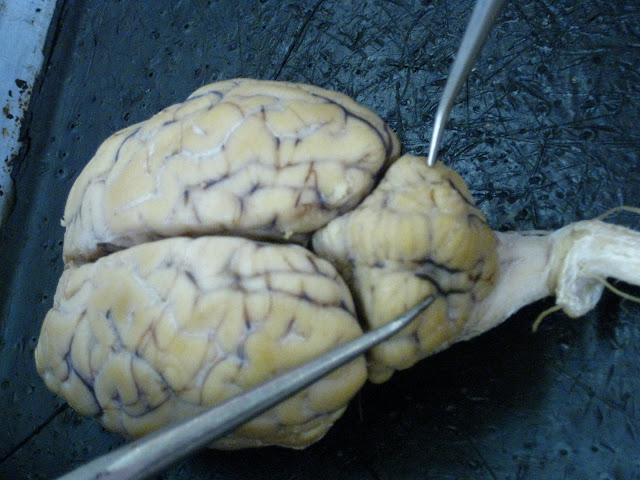Here's a link to a nice pdf of sheep brain dissections.
Meninges (Dura mater, Arachnoid mater, Pia mater) - no sheep pictures (not visible); identification on human brain for lab exam 2 of Dura Mater & Arachnoid mater.
Meninges (Dura mater, Arachnoid mater, Pia mater) - no sheep pictures (not visible); identification on human brain for lab exam 2 of Dura Mater & Arachnoid mater.
Falx cerebri (of Dura mater):
Tentorium cerebelli (of Dura mater):
 |
| Tentorium cerebelli is the "strip" of Dura Mater between the Cerebrum and Cerebellum; more specifically, Tentorium cerebelli lines the Transverse fissure. |
Cerebral Hemispheres (2) - aka Cerebrum/Telencephalon:
Longitudinal fissure (of Telencephalon/Cerebrum):
 |
| pic 1 |
 |
| pic 2 |
Gyrus:
 |
| Gyri are "hills" of brain tissue. |
Sulcus:
 |
| Sulci are "valleys" in brain tissue. |
Corpus callosum:
 |
| Internal view 1 of Corpus callosum ("roof" of the lateral ventricles, aka 1st and 2nd ventricles). |
 |
| External view 1 of Corpus callosum. |
 |
| Internal view 2 of Corpus Callosum. |
 |
| External view 2 of Corpus callosum. |
Gray matter (non-myelinated axons):
 |
| Gray matter of Cerebellum/arbor vitae. |
White matter (myelinated axons, Oligodendrocytes):
 |
| White matter of Cerebellum/arbor vitae. |
Frontal lobe (of Telencephalon/Cerebrum):
Olfactory bulbs (of Frontal lobe):
Olfactory tract (of Frontal lobe):
Parietal lobes (of Telencephalon/Cerebrum):
Temporal lobes (of Telencephalon/Cerebrum):
 |
| Probe is pointing to the left Temporal lobe. |
Occipital lobes (of Telencephalon/Cerebrum):
Diencephalon:
Optic chiasm(a):
 |
| Sagittal section/view of Optic chiasma. |
Pituitary gland: (cut off in all specimens, no class picture available for sheep brain).
Infundibulum (aka "Pituitary stalk" of Pituitary gland):
 |
| Probe is pointing through the hole where the Infundibulum would normally emerge, had it not been cut off. Infundibulum is the "stalk"/small tube that the Pituitary gland hangs from. |
Tuber cinereum (of Pituitary gland):
 |
| Tuber cinereum is the tan-colored circle surrounding the hole where the Infundibulum would normally be. |
Mammillary body:
 |
| Mammillary body is the structure located opposite the Optic chiasma. Function of Mammillary body has to do with linking emotion with olfactory (sense of smell) memory. |
 |
| Sagittal section/view of Cerebellum. |
 |
| Bird's Eye view of Cerebellum. |
 |
| Side view of Cerebellum. |
Transverse fissure (of Cerebellum):
 |
| Transverse Fissure of the Cerebellum is where the Tentorium cerebelli (made of the Dura mater meninx) would normally be located. |
Cerebellar hemispheres (of Cerebellum):
Arbor vitae (of Cerebellum):
 |
| Sagittal section of Cerebellum reveals Arbor vitae ("Tree of Life" pattern of white matter). |
Midbrain (aka "Mesencephalon")- structures of the Midbrain are: Pineal gland, Corpora quadrigemina, Cerebral aqueduct, Cerebral peduncles.
Cerebral peduncles (part of Midbrain or Mesencephalon; of Brainstem):
 |
| Probes are pointing to the left and right Cerebral peduncles, respectively, on the inferior surface of the brain. |
 |
| Lateral/side view of a Cerebral peduncle. |
Corpora quadrigemina (aka "tectum"; of Brainstem):
 |
| Probe is pointing to the Superior colliculi, but this is the general area of the Corpora quadrigemina of the Brainstem, tucked between the Cerebrum and Cerebellum. |
Superior colliculi (of Corpora quadrigemina; of Brainstem):
 |
| Probe is pointing to the Right Superior colliculus (bigger "butt cheek"). |
Inferior colliculi (of Corpora quadrigemina; of Brainstem:
 | |
|
Pineal gland (of Brainstem):
 |
| Posterior view of Pineal gland. |
 |
| Sagittal section/view of Pineal gland. |
Pons (part of Myelencephalon; of Brainstem):
 |
| Pons is located immediately posterior to the Cerebral penduncles. |
Medulla oblongata (part of Myelencephalon; of Brainstem):
 |
| Probe indicates general area of Medulla oblongata. |
 |
| Sagittal section/view of Medulla oblongata. |
Ventral median fissure (of Medulla oblongata):
 |
| Probe is pointing to the Ventral median fissure (dark line) of the Medulla oblongata. |















Thanks to Dr Williams I am so happy today, my wife have been suffering from pineal cyst for the past 8 years now, and i have spent a lot on western drugs which has all proved abortive, i have tried all means in life to get my wife out of this , but there was no answer until i decided to try herbal solution and i found Dr Williams online and i contacted him and after she took his medication as instructed, my wife is now completely cure from pinela cyst within those week of usage, i am so much happy, thanks to Dr Williams for helping me get my wife life back again without any form of crisis, i promise to tell your name and good deeds to the whole world,if you have someone with pineal cyst you can email him on drwilliams098675@gmail.com for more information .
ReplyDeleteI recently have some difficult conversations and I did what a lot of people do when they want to know more about something. I googled it. I came across Dr Williams herbal medicine on YouTube so many people thanking him about his good work. I also have pineal cyst. I wasn’t running all over God’s creation with every man I could find but here I am. I have felt bad about myself for so many years now because of my pineal cyst status. I obviously still have some self-accepting to do but I want to thank Dr Williams for everything he have done for my life ,after taking Dr Williams medicine i was completely free from pineal cyst within one month of usage, I think what you are doing is so admirable. you have helped me a lot! I want to definitely reach out to you and thank you for your amazing work. You are a good person, and an extremely talented man. You have helped millions with your herbs, and have really inspired me,and i pray you still continue doing the good work.you can also email him on drwilliams098675@gmail.com for help
ReplyDelete